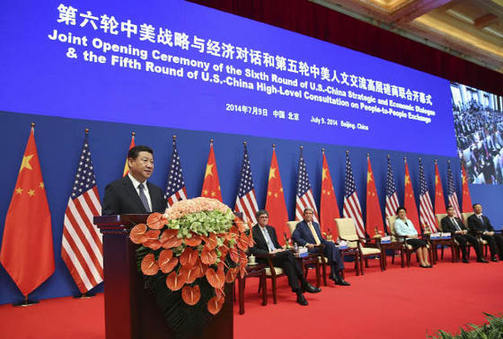Dialogue Mechanism Leads to New Sino-U.S. Relations
By ZHANG XUDONG
In his 1961 inauguration address President John F. Kennedy said: “If a beachhead of cooperation may push back the jungle of suspicion, let both sides join in creating a new endeavor – not a new balance of power, but a new world of law – where the strong are just, and the weak secure, and the peace preserved. All this will not be finished in the first one hundred days. Nor will it be finished in the first one thousand days; nor in the life of this Administration; nor even perhaps in our lifetime on this planet. But let us begin.”
This famous remark signifies the human resolve to work for lasting peace in the gloomy years of the Cold War. Half a century later history comes to another turn, and China and the U.S. must choose what kind of world they will share.
In a sense, today’s Sino-U.S. ties demand the same courage and commitment seen in China 30-odd years ago, when it began reforms by “crossing the river by feeling the stones.” Over the past 35 years, Sino-U.S. relations have survived many rocky periods and evolved into a barometer of international relations.
From the very start, cross-Pacific ties have been anchored on three realms of cooperation – politics, trade and economy, and people-to-people exchanges. Over the past decade the dialogue mechanism between China and the U.S. has stood out around the world with its increasing frequency and maturity. At the top of this mechanism are the China-U.S. Economic and Strategic Dialogue (S&ED) and the High-Level Consultation on People-to-People Exchanges (CPE), supported and supplemented by various sub-dialogues and discussions. These contribute as a whole to a maturing Sino-U.S. relationship.
On July 9-10, 2014 the sixth round of S&ED and the fifth round of CPE talks convened in Beijing. Chinese President Xi Jinping attended the joint opening ceremony and delivered a speech entitled “Work Hard to Build a New Model of Major Power Relationships between China and the U.S.” President Barack Obama also sent a message.
 |
|
Chinese President Xi Jinping delivered a speech at the joint opening ceremony of the sixth round of S&ED and the fifth round of CPE talks in Beijing on July 9, 2014. |
Xi remarked that, in 1979, Deng Xiaoping enjoined both countries to view China-U.S. relations from a long-term strategic perspective and in the context of the global situation. Over the next 35 years, despite profound changes in the international environment and conditions in both nations, China-U.S. relations have overcome difficulties and continue to move forward. The reason is that several generations of leaders in both countries have consistently given new meanings and motivation to Sino-U.S. relations. Today, both sides should better observe the times and creatively explore new prospects in bilateral cooperation.
In his written speech President Barack Obama welcomed the emergence of a stable, peaceful, and prosperous China. He is committed to joining hands with the Chinese side to build a new model of major power relationship, strengthen practical cooperation and resolve divergences in a constructive manner.
Observers have noted that America’s vision is somewhat different from China’s proposal of a relationship characterized by “no conflict, no confrontation, mutual respect and cooperation with win-win results.” It will take time for the U.S. to fully embrace the Chinese concept. It is significant, however, that the two sides have broadened their consensus on this issue, building up resolve and moving towards the same strategic goals.
